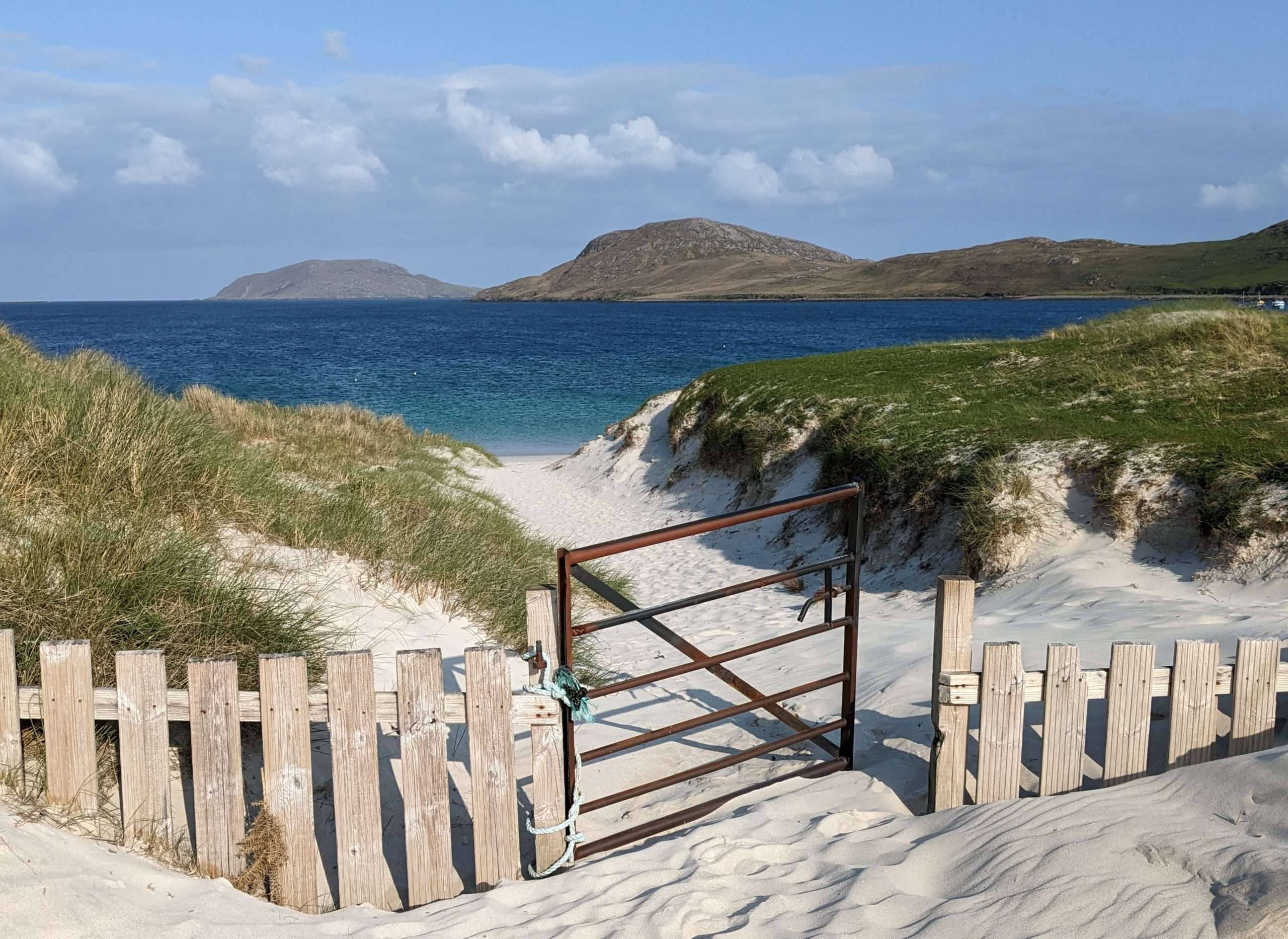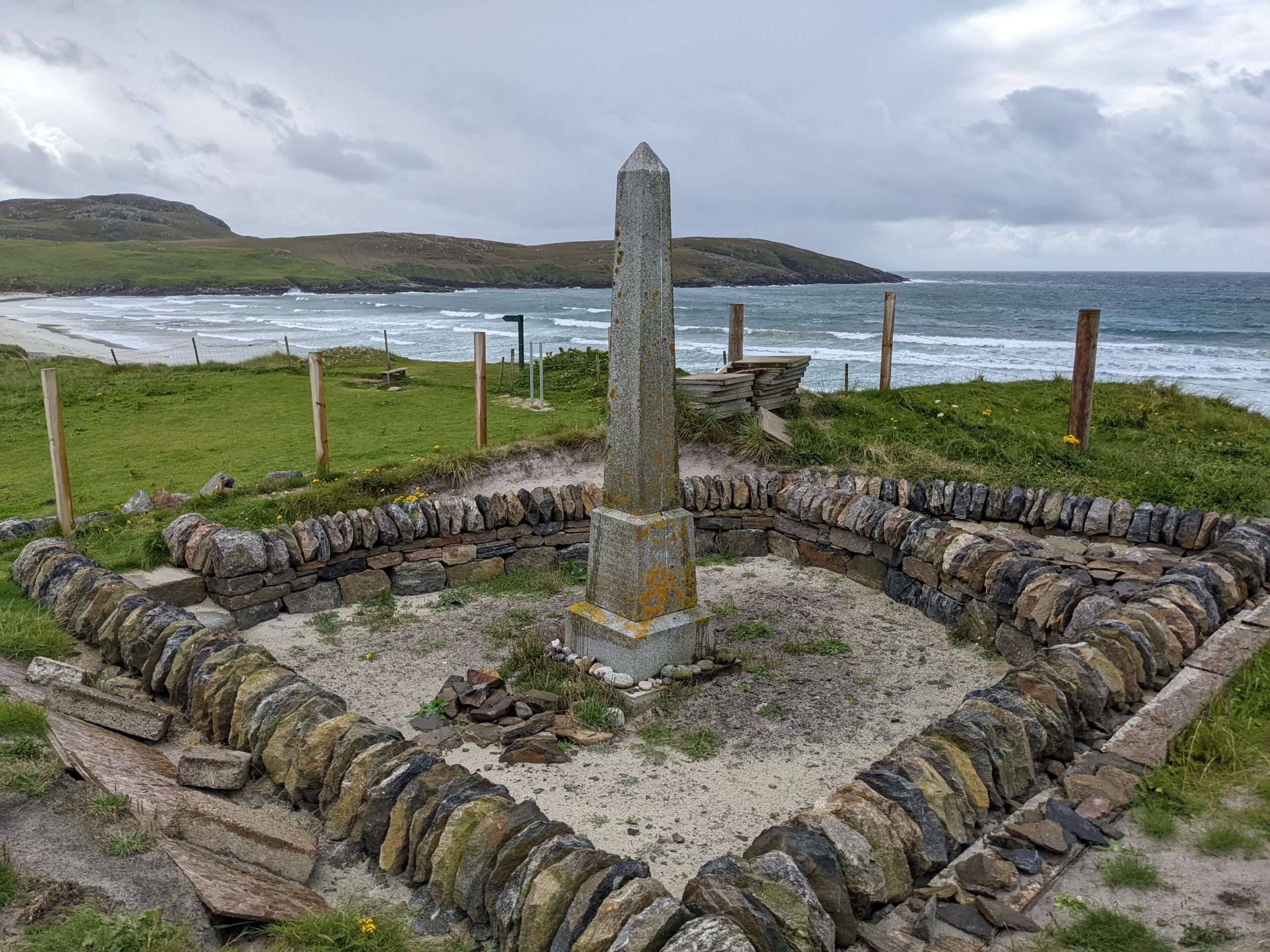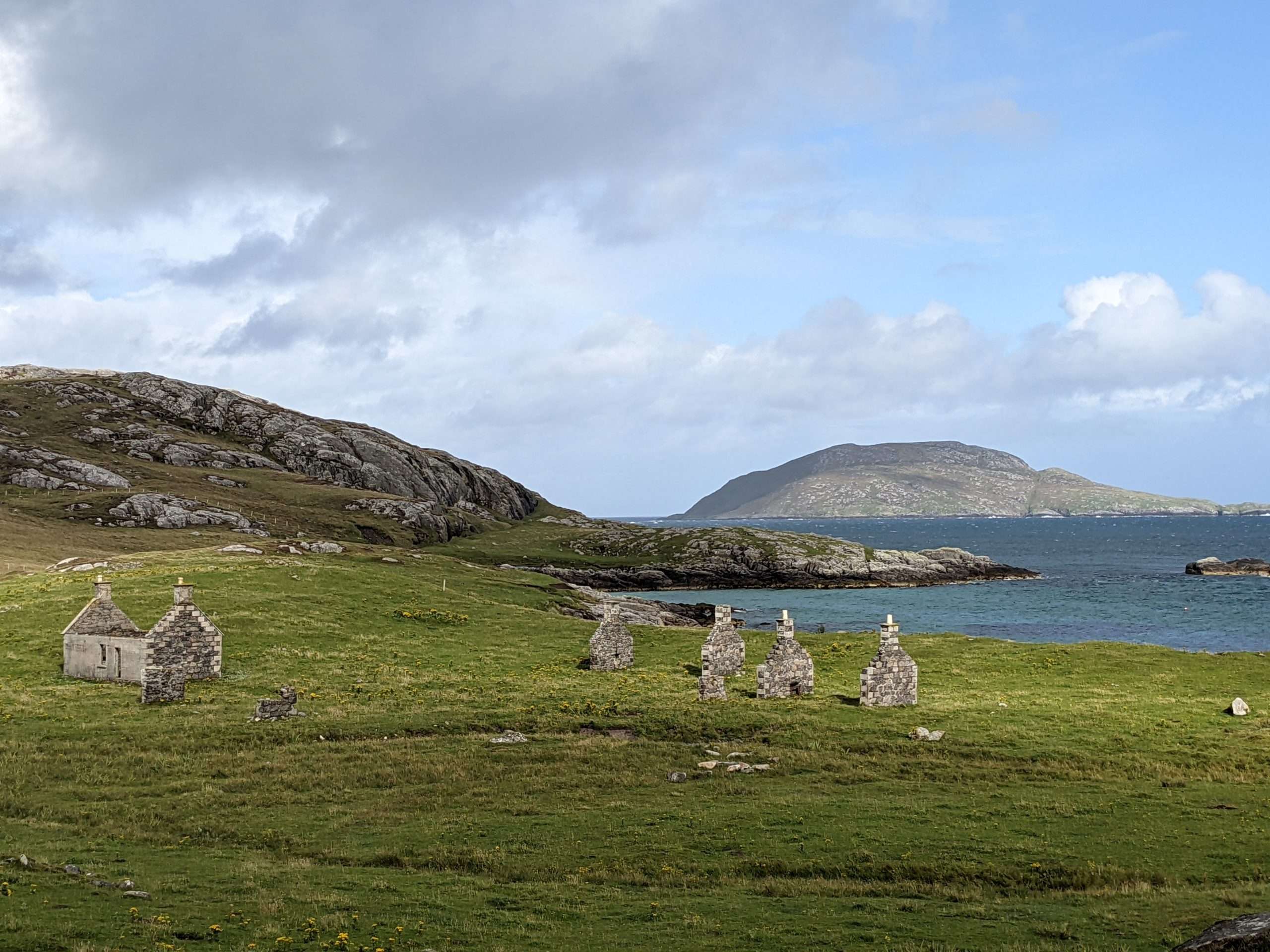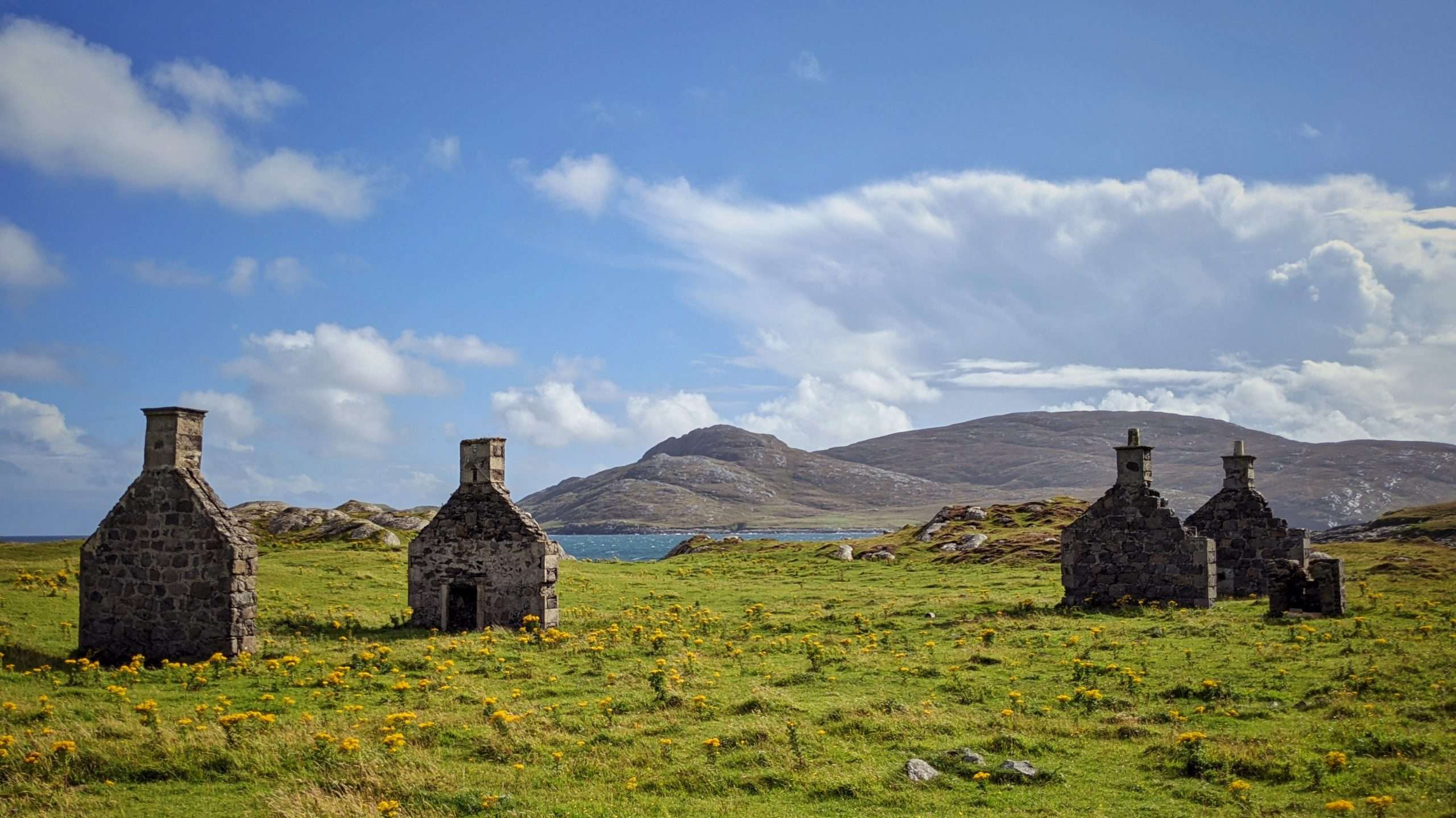Vatersay is so often spoken of in the same breath as Barra, its larger and only recently-conjoined sibling to the north. Most visitors to the two islands make a quick foray to the famously beautiful Vatersay Bay before returning to Barra and, often, progressing north to Eriskay and the Uists along the Hebridean Way.
Dwell in Vatersay a while longer, however, and you will find a community and history worth knowing in much greater depth. It is a place I have returned to five times already, and one which – despite being there just two days ago when writing this – I already yearn to see again.
The Meallaich

Everyone has their own pictorial metaphor for how Vatersay appears on a map. A quartet of peninsulas extend out on an east-west axis from its pinched middle, that glorious central strand of white sands and dunes littered with creels and cattle. I think of it as a butterfly, one wing larger than the other with a brittle middle. The Meallaich, the local name for the sandy tie that binds Vatersay’s two hilly halves, formed 7,000 years ago when sea levels were lower. In the grand scheme of things – and we are talking about a land where the exposed Lewisian gneiss is among the oldest rocks in the world – Vatersay’s status as a single island is a relatively new phenomenon.
When the first people arrived in the Outer Hebrides they beheld two islands, not one. So, it may be again. Some estimates say that by the end of this century, Vatersay will once more be split by the sea. It has not been unknown for particularly harsh storms to wash over the Meallaich to temporarily strand Vatersay from itself again.
Vatersay’s ancient inhabitants left quite a few traces of themselves for us to follow. The island has several brochs and dùns, Iron Age stone towers and stone-walled enclosures, respectively, which may have served as the local headquarters of elite families. Dùn Chaolais in the north and Dùn Vatersay in the south are the two best-preserved examples. There are also a handful of small standing stones located in hill passes, and the ruins of an early medieval Celtic chapel at the very tip of the beach-laden Uidh peninsula accessible only at low tide.

The personalities of the two beaches on either side of the Meallaich can differ wildly from each other. On a calm day Vatersay Bay (Bàgh Bhatarsaigh) is heavenly. Its broad and gentle curve, backed by dunes laden with marram grass, looks out to a sea of turquoise and silver ribbons. Even when the weather turns, which it can in an instant, there is something irrepressibly joyous and calming about it. Cross the band of dunes and make for the West Beach (Tràigh Siar), however, and a different character enters the story. Beautiful it is, certainly, yet the water here is greyer and colder in spirit. The unabated Atlantic crashes onto the sands, channelled by craggy shores to the north and south. It is fearsome where Vatersay Bay is placid, menacing where its counterpart is inviting. Though perhaps that perception has something to do with knowing what happened here.
Shipwrecks were a common feature of life in these isles, but the wreck of the Annie Jane during the night of September 28th – 29th, 1853, will be remembered by the people of Vatersay for many years still to come. Sailing out from Liverpool and bound for Quebec, the Annie Jane carried around 500 people including crew and children, many of whom were emigrants from various parts of Scotland, England, and Ireland. Damaged in a storm off St Kilda, the Annie Jane drifted helplessly back towards the Barra Isles and shattered upon the submerged rocks of Tràigh Siar. Only a little more than one hundred survived. The rest were buried among the dunes, and still lay somewhere within them. They are commemorated by a small monument which overlooks the scene of the tragedy. In this resting place they join many others from ages past. A dense concentration of Bronze Age funerary cairns dot the bay’s northern shore at Treasabhaig, dubbed by the archaeologists who surveyed them as the ‘valley of the dead’.
The Vatersay Raiders

Yet tragedy is just one part of Vatersay’s story. Another is people power. In the late 19th century and early years of the last century, the absentee aristocratic landlord Lady Gordon Cathcart evicted the tenants of Vatersay’s multiple settlements and ran the whole island as one large sheep farm. Several years later, some among the original tenants who had relocated to Barra sailed back to their homelands to reclaim and rebuild their crofts.
These were the Vatersay Raiders, and their resistance to oppression and desolation drew national headlines. Cathcart’s overseer in Vatersay rounded up the Raiders’ cattle and demanded payment for the release of each one, but Duncan Campbell opened the pens and freed them. Cathcart’s rebukes echo the sentiments of modern wealthy landlords, saying that MPs sympathetic to the Raiders were “hostile to business” and that the people of Barra and Vatersay should, in only slightly modified language, simply pick themselves up by their bootstraps instead of clinging to their old, outdated ways.

The Vatersay Raiders faced a trial in Edinburgh, with images of them circulated in newspapers garnering widespread public support for their cause. Ultimately they were released and crofts were re-established in Vatersay, which was bought from Cathcart by the government. The most evocative of the Raiders’ reclaimed settlements is Eòrasdail, located in the southwestern extremity of Vatersay and inhabited until c.1966. There stands a single roofless house and the gable ends of several more, with traces of lazy beds for potatoes, cairns of stones cleared from the surrounding fields, and iron fittings still in place. Descendants of the Vatersay Raiders still call the island home, and speak with great pride about what they achieved against all material and political odds.
I like to think that the Raiders would have stood alongside modern residents in celebrating the opening of a causeway connecting Vatersay to Barra by land for the first time ever in 1991. Prior to this it was only possible to go between the two by boat, an often perilous journey despite its shortness. Many images in the archives of Dualchas, the heritage centre in Castlebay, Barra, show cattle being precariously swum across the Sound of Vatersay led by men in small boats. Numerous records mention several extended periods where crossings were impossible due to weather. Now, in no small part due to the lifeline of the causeway, Vatersay joins Barra as the only islands in the Outer Hebrides which are not only maintaining but growing their populations.
Episodes of tragedy and promise, of upheaval and resurgence, of hardship and liberty: these are the notes in the millennia-spanning song of Vatersay. The land itself seems aware of this, with idyllic machair beaches – not just Vatersay Bay and West Beach but also the smaller but magnificent Bàgh a’ Deas (South Bay) and Tràigh Bharlais in the northwest – giving way to harsh and bare uplands. If you ever get the chance to be there, do yourself a favour and don’t just pop over to Vatersay Bay for a picnic and photo opp. Stay a while, and dance along the butterfly’s outstretched wings.
Text and photos by: David C. Weinczok.

